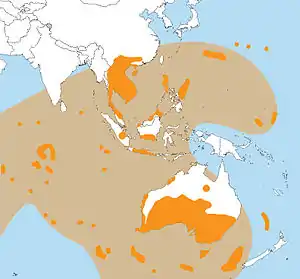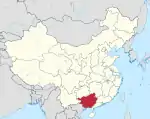Australasian strewnfield
The Australasian strewnfield is the youngest and largest of the tektite strewnfields, with recent estimates suggesting it might cover 10%–30% of the Earth's surface.[1][2][3] Research indicates that the impact forming the tektites occurred around 788,000 years ago, most likely in Southeast Asia.[4][5]

Introduction
The c. 788,000-year-old strewnfield[4] includes most of Southeast Asia (Thailand, Laos, Vietnam, Cambodia, and Southern China). The material from the impact stretches across the ocean to include the Philippines, Indonesia, Malaysia, and Java. It also reaches far west out into the Indian Ocean, and south to Australia, including Tasmania. Since the 1960s, it has been accepted that the strewnfield included Hainan in southern China to Australia or about 10% of the Earth's surface.[5] This was later extended by finds in Africa and Tasmania to 20%. Additional finds in northern Tibet, Guangxi and Antarctica increased the strewnfield to about 30% of the Earth's surface, or almost 150,000,000 km2 (58,000,000 sq mi), or about the size of the entire world's landmass.[6][7]
Source crater
The current consensus is that the source impact crater for the Australasian strewnfield lies somewhere in Southeast Asia. It is argued that due to the enormous size of the Australasian strewnfield, the source impact crater must be significantly larger in size than the source impact craters of the other known strewnfields.[6][8][9][10] Many locations have been proposed for this missing source crater. Schmidt and Wasson (1993) suggested there could be a 14–17 km (8.7–10.6 mi), in diameter source crater beneath the Mekong Valley,[9] Hartung and Koeberl (1994) proposed the elongated 35 by 100 km (22 by 62 mi) Tonlé Sap lake in Cambodia,[10] Glass (1994) estimated the source crater to be between 32–114 km (20–71 mi) in diameter and located in Cambodia,[8] and Schnetzler (1996) suggested a 35–40 km structure in southern Laos.[11] Later, Glass (1999) also considered southern Laos or an adjacent area as a possible source.[12] Lee and Wei (2000) concluded that the source of the Australasian strewnfield is a large impact crater in Indochina and estimated it to be 90–116 km (56–72 mi) in diameter.[13] Other proposed locations are between southern Laos and Hainan by Ma et al. (2001)[14] and possibly within the Gulf of Tonkin as argued by Whymark.[15] More recently in 2020, Sieh et al. proposed on the basis of various lines of evidence that the crater lies buried beneath the Bolaven volcanic field in southern Laos.[16] In 1991, Wasson et al. studied layered tektites in central Thailand[17][18] and explained the lack of a large recognizable source crater by occurrence of small, diffuse, multiple impact event spread out over the region. This explanation raises some problems, in particular the strewnfield's tektites having a different chemical composition than Cambodian sandstone from the time of impact.[10]
The lack of a recognizable source crater in Southeast Asia has also been explained by proposing it being located outside of Southeast Asia. Some of these proposed locations for the source of the Australasian strewnfield lying outside of Southeast Asia include the Wilkes Land crater in Antarctica,[19] the Zhamanshin crater in Kazakhstan, [20] and the Elgygytgyn crater in Siberia.[21]
Brunhes–Matuyama reversal
It has been proposed that the impact may have triggered the Brunhes–Matuyama reversal of 781,000 years ago.[22] This proposal was based on the apparent contemporaneous timing of the Brunhes–Matuyama reversal and occurrence of Australasian tektites in cores of pelagic deep sediments and apparent association of tektites of two other strewn fields, including the Ivory Coast strewn field, in deep sea cores with other magnetic reversals.[23] In 1985, Muller and others[24] proposed a geophysical model that explained the magnetic reversals as the result of a decrease in geomagnetic field intensity associated with a minor glaciation that was caused by and followed the impact event. In the early 1990s, Schneider and Others[25] conduct a detailed isotopic, geophysical and paleontological analysis of deep sea cores and concluded that the Australasian impact event preceded the Brunhes-Matuyama reversal of magnetic field by about 12,000 years; that the field intensity was increasing near the time of impact; and increased for 4,000 years afterward. They also found a lack of any indication of discernible climate cooling (minor glaciation) following the impact as predicted by Muller and others in their 1985 model. They also found that during the critical interval after the impact: deglaciation, in fact, occurred. Based upon these findings, they did not support the proposition that the Australasian impact event and Brunhes-Matuyama reversal were associated with each other.[25] A similar study of the association between Ivory Coast strewn field and the onset of the Jaramillo normal polarity subchron found them also not to be contempraneous as previously inferred. They were separated in time by 30,000 years.[26]
Homo erectus

Archeological artifacts found with these tektites in Baise, Guangxi in southern China indicate that a Homo erectus population was living in the area during and after the impact.[27][28][29][30] Stone tools have been found within the debris field along with a charcoal layer likely caused by fires from the impact. It has been suggested that the subsequent local deforestation after the fires allowed this population easier access to stones useful for tool-making.[27]
References
- Glass, B.P. and Wu, J., 1993. Coesite and shocked quartz discovered in the, Australasian and North American, microtektite layers. Geology, 21(5), pp.435-438.
- Prasad, M.S., Gupta, S.M. and Kodagali, V.N., 2003. Two layers of Australasian impact ejecta in the Indian Ocean?. Meteoritics & Planetary Science, 38(9), pp.1373-1381.
- Prasad, M.S., Mahale, V.P. and Kodagali, V.N., 2007. New sites of Australasian microtektites in the central Indian Ocean: Implications for the location and size of source crater. Journal of Geophysical Research: Planets, 112, no. E06007, 11 pp.
- Jourdan, F., Nomade, S., Wingate, M.T., Eroglu, E. and Deino, A., 2019. Ultraprecise age and formation temperature of the Australasian tektites constrained by 40Ar/39Ar analyses. Meteoritics & Planetary Science, 54(10), pp.2573-2591.
- Westgate, J.A., Pillans, B.J., Alloway, B.V., Pearce, N.J. and Simmonds, P., 2021. New fission-track ages of Australasian tektites define two age groups: discriminating between formation and reset ages. Quaternary Geochronology, 66, no. 101113, 18 pp.
- Povenmire H., Liu W. and Xianlin I., 1999. Australasian tektites found in Guangxi Province, China. 30th Annual Lunar and Planetary Science Conference, Houston, March 1999, no. 1072, 1. p
- Soens, B., Van Ginneken, M., Chernonozhkin, S., Slotte, N., Debaille, V., Vanhaecke, F., Terryn, H., Claeys, P. and Goderis, S., 2021. Australasian microtektites across the Antarctic continent: evidence from the Sør Rondane Mountain range (East Antarctica). Geoscience Frontiers, 12(4), no.101153, 13 pp.
- Glass, B.P. and Pizzuto, J.E., 1994. Geographic variation in Australasian microtektite concentrations: Implications concerning the location and size of the source crater. Journal of Geophysical Research: Planets, 99 no. E9, pp.19075-19081.
- Schmidt G. and Wasson J., 1993. Masses of the impactor, the Australasian tektites, and size estimates of the main source crater. Meteoritics, 28(3), pp.430-431
- Hartung J. and Koberl C., 1994. In search of the Australasian tektite source crater: The Tonle Sap hypothesis. Meteoritics, 29, pp. 411-416.
- Schnetzler C.C. and Mchone J.F., 1996. Source of Australasian tektites: Investigating possible impact sites in Laos, Meteoritics & Planetary Science, 31, pp. 73-76
- Glass B.P. (1999) Muong Nong-type Australasian tektites: implications regarding the parent material and source area Ninth Annual V.B.m Goldschmidt Conference, Massachusetts, August 1999.
- Lee, M.Y. and Wei, K.Y., 2000. Australasian microtektites in the South China Sea and West Philippine Sae: implications for age, size and location of the impact crater “Meteoritics & Planetary Science, 35( 6) pp. 1151-1155.
- Ma, P., Tonzola, C., DeNicola, P., Herzog, G.F. and Glass, B.P., 2001. 10 in Muong Nong-Type Australasian Tektites: Constraints on the Location of the Source Crater. Lunar and Planetary Science Conference XXXII, no. 1351.
- Whymark, A., 2021. A review of evidence for a Gulf of Tonkin location for the Australasian tektite source crater. Thai Geoscience Journal, 2, pp.1-29.
- Sieh, K., Herrin, J., Jicha, B., Schonwalder Angel, D., Moore, J.D., Banerjee, P., Wiwegwin, W., Sihavong, V., Singer, B., Chualaowanich, T. and Charusiri, P., 2020. Australasian impact crater buried under the Bolaven volcanic field, Southern Laos. Proceedings of the National Academy of Sciences, 117(3), pp. 1346-1353.
- Wasson, J.T., 1991. Layered tektites: A multiple impact origin for the Australasian tektites. Earth and Planetary Science Letters, 102(2), pp. 95-109.
- Wasson, J.T., Pitakpaivan, K., Putthapiban, P., Salyapongse, S., Thapthimthong, B. and McHone, J.F., 1995. Field recovery of layered tektites in northeast Thailand. Journal of Geophysical Research: Planets, 100(E7), pp. 14383-14389.
- Schmidt, R.A., 1962. Australites and Antarctica. Science, 138(3538), pp. 443-444.
- Glass, B.P., 1979. Zhamanshin crater, a possible source of Australasian tektites?. Geology, 7(7), pp. 351-353.
- Dietz, R.S., 1977. Elgygytgyn crater, Siberia: Probable source of Australasian tektite field (and Bediasites from Popigai) . Meteoritics, 12(2), pp.145-157.
- Glass B.P. and Heezen B.C., 1967. Tektites and geomagnetic reversals. Scientific American, 217(1), pp. 32-38.
- Glass, B.P., Swincki, M.B., and Zwart, P.A., 1979. Australasian, Ivory Coast and North American tektite strewnfields - Size, mass and correlation with geomagnetic reversals and other earth events. Lunar and Planetary Science Conference, 10th, Houston, Tex., March 19–23, 1979, pp. 2535-2545.
- Muller, R.A. and Morris, D.E., 1986. Geomagnetic reversals from impacts on the Earth. Geophysical Research Letters, 13(11), pp.1177-1180.
- Schneider, D.A., Kent, D.V. and Mello, G.A., 1992. A detailed chronology of the Australasian impact event, the Brunhes-Matuyama geomagnetic polarity reversal, and global climate change. Earth and Planetary Science Letters, 111(2-4), pp.395-405.
- Schneider, D.A. and Kent, D.V., 1990. Ivory Coast microtektites and geomagnetic reversals. Geophysical Research Letters, 17(2), pp.163-166.
- "Handaxe and tektites in Bose, China". Archived from the original on 2011-08-30. Retrieved 2012-04-23.
- Pillans, B., Simmonds, P., et al (2012) "Tektites, minitektites and microtektites from the Kalgoorlie region, Western Australia", Australian Regolith and Clays Conference, Mildura, 7–10 February 2012.
- "SCI/TECH | Asia's oldest axe tools discovered". BBC News. 2000-03-03. Retrieved 2015-10-20.
- Antón, Susan C.; Swisher, Iii, Carl C. (October 2004). "Early Dispersals of Homo from Africa". Annual Review of Anthropology. Annual Reviews. 33: 271–296. doi:10.1146/annurev.anthro.33.070203.144024.

